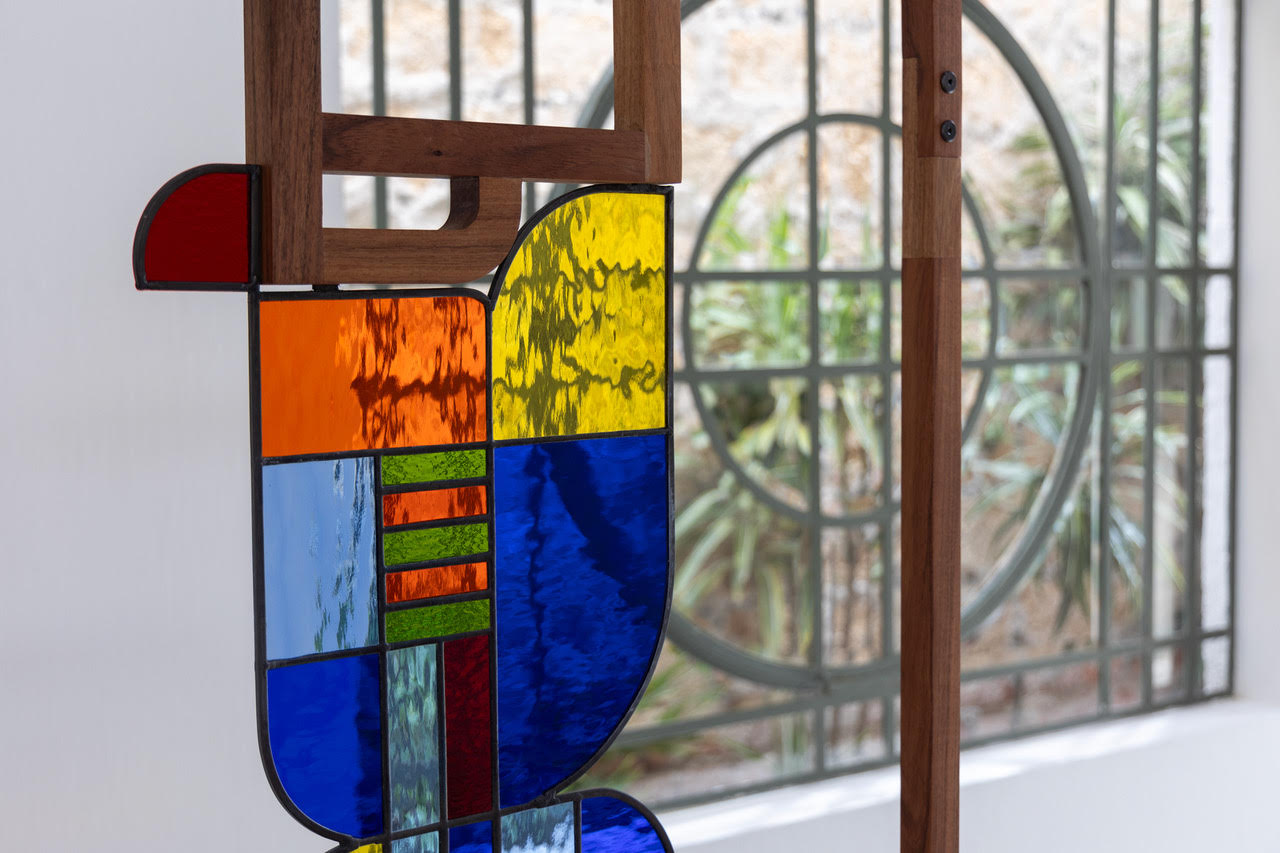
Mauricio Limón de León
Géneros arcanos
Performance
-> Oct 11
Naranjo 141
As part of Mauricio Limón de León's Géneros arcanos, Pequod Co. presents a performance at Naranjo 141. Presented by Clarissa Rollo and Seda Tesch, with music by Raúl Vizzi and Alejandro Contreras "Pascual" and costumes by Isabel Manhes.
It all starts with an Art Déco stained glass window in Amsterdam. The brilliance of its colours and the geometry of its shapes—brought to life by the passage of natural light—serve as the initial source of inspiration for a body of work created by Mauricio Limón in 2022 and exhibited at Ellen de Bruijne Projects. The main motif of this production is the synthesis between the rigid grid of the original composition and the fluidity of the body shapes. In collaboration with Adriana Gonzalez Hulshof and Atelier Caraco in Paris, Limón creates dresses—textile sculptures in unique editions—that offer a reinterpretation of the designs that inspired them. Alongside the garments, a collection of stained glass works ‘immobilises’ those same forms: time rewinds to medieval stained glass windows, conceived as the materialisation of a pictorial narrative extended to space and architecture. A series of paintings made with white potassium completes the same conceptual idea which, passing from one medium to another, enacts an idea of trespassing between epochs, forms and languages.
Let’s take a step back: when Art Déco exploded across Europe—consecrated by the 1925 International Exhibition of Modern Decorative and Industrial Arts in Paris—it aimed to celebrate a new idea of modernity as a synthesis of all the arts. Architecture, visual and decorative arts, fashion, and design engaged in a constant dialogue, reshaping the aesthetic imagery of everyday life. In Holland, French Art Déco merged with the legacy of Art Nouveau and the rationality of De Stijl, seeking a balance between decoration and functionalism. Yet, behind its stylised forms, symmetrical compositions, and primary colours conceal distant influences that look to Africa and Asia—in line with the Orientalism then in vogue—but also from pre-Columbian civilisations. In this network of possible “communicating vessels,” history is woven like a warp, ideally linking Mayan and Aztec symbolism with the formal elegance of 1920s stained glass windows. A beautiful example of this spatial-temporal connection is the influence of Mexican visual culture on one of the most significant figures of Bauhaus: Josef Albers. Serving as a subject of a show held by the Guggenheim Museum in New York in 2018, the visits of Josef and Anni Albers to Mexico from the Thirties to the Sixties were undoubtedly a source of inspiration for Josef’s geometrical paintings, but also for Anni’s textile works, confirming the power of pre-Columbian art in shaping a European approach to Abstractionism.
Mauricio Limón stands in the middle of this interweaving of threads, drawing from both a European matrix and his Mexican roots. The title Arcane Genders recalls an idea of historical fluidity, even before interdisciplinarity: a form of esotericism capable of evoking remote times and mixing them, just as geometric rigidity dissolves in the sinuosity of bodies. Yves Saint Laurent had already explored this fusion with his iconic Mondrian Dress of 1965, a tribute to the father of the De Stijl movement, who reimagined his famous compositions as a fashion product. However, Limón's process is even more complex insofar as it is not a single quotation that comes into play but a layered set of references. Among them is Samuel Beckett, whose work inspires the choreographies that animate the bodies dressed in Limón’s
sculptural garments. For the 2024 Rooms Festival in Maastricht, four performers move on a sequence of gestures inspired by Quad, a short play for television written by the Irish writer and first broadcast in 1981. Their movements appear regulated by a clockwork structure drawn on the floor that acts as a stage and grid. Their poses suggest a mobility that is almost an escape from an idea of structure, essential but still reshapeable, recalling a form of ritual where the procedure might be rewritten by the unpredictable. In the end, their bodies become architecture. Once the performers disrobe, the garments return to hangers that are themselves sculptural objects, whose lines continue to echo modernist forms.
This brings us to the exhibition at Pequod, where new elements are added to an already layered narrative. The gallery’s exhibition spaces naturally resonate with the forms of the stained glass and garments, emphasising the relationship between body and architecture through the display of seven stained glass screens based on the original designs.
As if by magic, these works seem to lose their original Art Déco references and instead embrace the figurative traditions of ancient Mesoamerican civilisations, rediscovering an indigenous component as an unintentional inheritance. The relationship with nature, which emerges in the designs of the traditional weaving techniques of certain areas of Chiapas and of the Wixárica culture, seems to take the place of Dutch formal rationality. Added to this scenario is a series of paintings that evoke skin, with its abstract veins, sealing a dialogue between presence and absence. Just as the garments rest on their carefully designed sculptural hangers, waiting for a body to inhabit and animate them, these painted surfaces act as shells—liminal spaces between interior and exterior—that bear the traces of lived experience. (Not by chance, it is said “to live something on one’s skin.”)
In light of the evolution of this cycle of works—which begins with the coldness of stained glass and culminates in the sensuality of human flesh—it becomes clear that what Mauricio Limón draws from Art Déco is not merely an aesthetic reference, but rather a methodology: a form of contamination between different arts and techniques, used to narrate a process of transformation.
The arcane genders of the title are thus an invitation to explore the interconnections between architecture and nature, design and materiality, myths and rituals, mind and body, in search of an access key that seeks to intercept those subterranean plots on which the original breath of the world is based.
–Alessandra Troncone